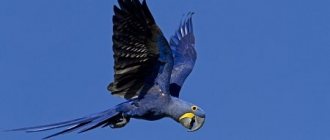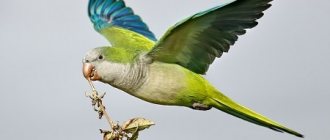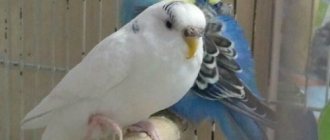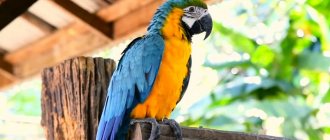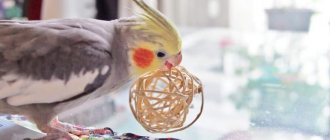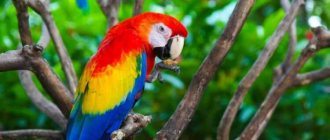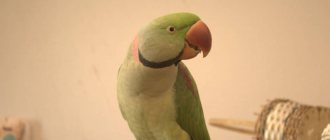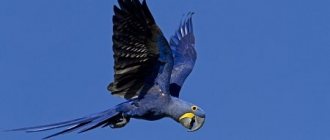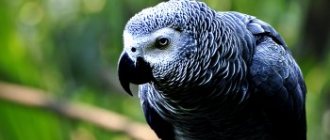Where do macaws live?
The habitat of Macaw parrots in the wild is the tropical forests of Central and South America, as well as the islands of the Caribbean. But at the same time, each subspecies is characterized by its own habitat region.
| Subspecies Macaw | Localization in the wild by region |
| Blue-yellow | Panama, Brazil, Paraguay |
| Green-winged | South America |
| Red | Central America |
| Soldier's | America's Central Regions |
| Nicaraguan | Panama, Nicaragua, Costa Rica |
| Blue-throated | Northern Bolivia |
| Hyacinth | Brazil, Paraguay, Bolivia |
| Red-eared | Bolivia |
| Blue-fronted | Amazon River basin from Guiana and Venezuela to Brazil |
| Chestnut-headed | Panama, western and central Brazil, northern and central Bolivia |
| Soldier's small | Colombia, Mexico, Bolivia |
| Yellowneck | Argentina, Paraguay, Bolivia, Brazil |
| Redback | Brazil, Paraguay |
| Bluehead | Western Peru, Eastern Brazil, Northwestern Bolivia |
| Red-bellied | Brazil, Colombia, Southern Venezuela, Guyana, Peru, eastern Ecuador |
Places inhabited by macaw parrots
Lifestyle
In the wild, Macaws live in flocks and roam in small groups. In addition to excellent flying abilities, they can crawl between tree branches using their paws and beak. During the mating season, the birds split into pairs. It is worth noting that Macaws are monogamous birds and they choose a partner for life. If one of the partners dies, the other remains single forever.
This feature affects birds at home. They are attached exclusively to one owner. Thanks to their loud and sharp voice, birds reproduce a variety of sounds and speech without problems. But they publish them only under certain conditions, when communicating with relatives from the pack. In captivity, parrots of this species prefer physical contact for communication, and use their voice only to attract the attention of the owner.
General characteristics
The Macaw parrot is one of the most beautiful birds on Earth. Each of its subspecies has its own flavor and unique colorful plumage. But they all have common characteristics, according to which they are classified as one genus:
- Height (depending on the species) - from 30 to 100 cm.
- Body weight (depending on the species) – from 0.9 to 2 kg.
- The color of the plumage is variegated, the color varies from red to blue (females and males have no differences in color; large species are multi-colored, small ones are mostly green.).
- The beak is hook-shaped, compressed on the sides, strong, with a unique structure (inside the beak there is a small shelf-outgrowth with which the parrot operates like a human hand).
- The tongue is mobile (plays the role of a finger to help the beak-“hand”).
- The larynx has a complex “drum” structure (makes it possible to imitate sound).
- The wings are elongated and pointed.
- The tail is wedge-shaped, longer than the body.
- Vision is monogamous, my eyes can see two pictures at the same time in different projections.
- A special feature is the skin on the cheeks and near the eyes without feathers (with the exception of the hyacinth species, which has feathered cheeks).
How to choose a parrot
Of course, a large parrot is not a cheap bird, and after a potential owner finds out how much a macaw costs, he strives to purchase a young and, most importantly, healthy bird.
It is better to turn to specialists with this question. People who breed birds will help you make your choice, and you can be sure that the bird has a short life history behind it, and not dozens of years lived.
The younger the bird, the more docile it will be. This means that the process of socialization, education and training will be easier. An older bird will, of course, create certain difficulties.
The main thing is that the macaw parrot is healthy. A person ignorant of this issue will have a hard time, which is why it is better to turn to knowledgeable people. But if there are none in your environment, try to carefully examine the bird yourself.
She should have a clear, clean look and no discharge from the nose or eyes. The feathers of a healthy bird are smooth and shiny; bald patches, as well as swelling, should definitely alert you. In no case should there be growths or peeling on the bird’s paws, and the beak should also be without signs of damage or disease.
Sometimes there are advertisements where they offer to purchase an adult bird. This happens if the owner of the macaw has died or someone in the family has an allergic reaction. Of course, you can try to tame a bird that previously belonged to someone else. However, it is worth understanding that this process will not be easy, because the macaw already had an owner whom he loved, and it is not known how quickly he will get used to the new one.
Features of macaw parrots: character, intelligence
Beautiful external features are not the only feature of macaws. Nature gave them many talents and an extremely special character. These parrots are characterized by affectionate behavior, are quite curious, brave, friendly and love to communicate with people and other pets. But each chick, like people, develops its own character, which can manifest itself in different ways (for example, it can be capricious like a child if it doesn’t like something).
The macaw is an intellectually gifted bird that can speak. Birds have improved their mental abilities through evolution through constant contact with other fauna and humans. Scientists have proven that an adult Macaw is capable of pronouncing about 20 words, not just repeating what it hears, but also understanding speech. This confirms the high level of intelligence of these incredible birds.
Pros and cons of keeping poultry
Pros of the macaw parrot:
- no odor;
- ease of cleaning;
- high intelligence;
- cheerfulness;
- sociability;
- good health and longevity;
- does not need walking.
Macaws will easily serve as guards in any home and will make a terrible noise at the sight of a stranger. It was not for nothing that the indigenous population - the Indians - kept them as guards.
Cons of the bird:
- excessive jealousy;
- curiosity;
- the habit of chewing on everything, from pieces of paper to furniture;
- the bird makes a lot of noise and screams;
- bird bites are very painful;
- pet litters;
- the intelligent macaw requires a lot of attention;
- not suitable as a gift for a child.
Living species of macaw parrots
Modern macaws are usually divided into three groups: large, small and hybrid.
| Species of macaw parrot | Photo | Short description |
| Large species | ||
| 1. Blue-and-yellow (Ara ararauna) Endangered species listed in the Red Book! | Large species - up to 90 cm in length. It has a specific color - blue above and yellow below. | |
| 2. Greenwing (Ara chloropterus) | Large species with a red body and blue-green wings. Small red feathers appear on the bare areas of the cheeks. | |
| 3. Red, Arakanga, Macau (Ara macao) Red List endangered species! | Large species with predominantly red plumage. The wings have rows of feathers in yellow, green and blue. The beak is dark below and light above. | |
| 4. Soldier (Ara militaris) or Buffona, Nicaraguan, Great Green (Ara ambiguus) | The Great Soldier's Macaw is a large parrot with predominantly green plumage. Features of the subspecies are red feathers on the forehead, black small rows of feathers on the cheeks, blue and yellow inclusions in the tail and wings, and a black beak. | |
| 5. Blue-throated (Ara glaucogularis) Endangered species listed in the Red Book! | Reaches a length of 85 cm. The predominant plumage is yellow (on the belly), blue and green (torso, wings, head). The main difference is the blue plumage on the throat and the presence of blue-green feathers on the cheeks. | |
| 6. Hyacinth (Ara hyacinthinus) Red List of endangered species! | Considered the largest and most expensive macaw in the world. Its length reaches 100 cm. Differences include blue plumage, unfeathered yellow rings around the beak and eyes, fully feathered cheeks, and a gray beak. | |
| 7. Red-eared or red-fronted macaw (Ara rubrogenys) Red-listed endangered species! | Distinctive characteristics are red ears and shoulders, which stand out noticeably against the background of green plumage. | |
| 8. Gray or blue macaw, Spix (Cyanopsitta spixii) Completely extinct species in the wild!!! | Ornithologists are trying to preserve the blue macaw population in captivity, where its number is estimated at 500 individuals. It has blue-blue plumage with a sea-green tint, a dark beak, gray paws, and yellow eye frames. | |
| Small species | ||
| 1. Blue-fronted or lesser hyacinth (Ara nobilis) The species includes 3 subspecies: Red-shouldered, chestnut-fronted, North (Diopsittaca nobilis nobilis) Noble or dwarf macaw (Diopsittaca nobilis cumanensis) Neumann (Diopsittaca nobilis longipennis) | The Lesser Hyacinth Macaw is the smallest of the genus. Body length ranges from 30-35 cm. They are trainable and quickly learn to speak. The main color is dark green. The forehead is blue, the shoulders are red. | |
| 2. Small soldier's macaw (Ara militaris) The species includes 3 subspecies: Bolivian (Ara militaris bolivianus) Mexican (Ara militaris mexicanus) Military (Ara militaris militaris) | It differs from the large soldier's macaw in its smaller size and red stripes on its cheeks. Perfectly suitable for home keeping. | |
| 3. Yellow-necked Macaw (Ara auricollis) | Owners of green plumage and black-brown forehead. There are inclusions of blue, yellow and red on the wings. They feel great in captivity, but sometimes they like to escape. | |
| 4. Redback or Illigera (Ara maracana) | The gray-purple forehead blends perfectly into the tone of the green plumage. Red rows of feathers stand out on the belly and back. They are trainable and love intellectual games. | |
| 5. Red-bellied (Ara manilata) | The Lesser Red-bellied Macaw is distinguished by its iridescent colors of green, yellow and blue. The skin near the beak and on the cheeks is yellow. Rarely kept in captivity, due to the birds' tendency to scream loudly. | |
| 6. Mountain or blue-headed macaw (Ara couloni) | It has a blue head and wings with a brownish-brown tail, which stand out noticeably against the green background of the body. Suitable for taming and living in northern regions at temperatures from +10°C. | |
Parrot hybridization is a controversial topic. Some ornithologists insist that such birds should not be bred because they can introduce irreparable congenital mutations into the bird's lineage. Advocates of home breeding believe that hybrids are more beautiful, smarter and more resistant to disease than the living pure species from which they were bred. Despite the controversy among ornithologists, new hybrids continue to appear in the world and bring joy to their owners.
| Popular hybrid macaw species | |
| Harligold | Ruby |
| Soldier yellow | Calico |
| Shamrock | Verde |
| Catalina | Harlequin |
And also among the hybrids the following names are known:
- Maui Sunrise;
- Maui Sunset;
- Ruby;
- Camalot;
- Capri;
- Michicon;
- Star Light;
- Bluffon's Fire;
- Flame;
- Milligold;
- Buffalo;
- Anniversary;
- Rubalina;
- Tropican;
- Kaloshua.
Extinct species of macaw
There used to be 24 species of macaws, but unfortunately, seven species have completely disappeared and are considered extinct, and one species survives only in captivity.
| Parrot species | Image | Short description |
| 1. Guadalupe Macaw (Ara guadeloupensis or Anodorhynchus purpurascens) | It looked like a red macaw. Lived in the Lesser Antilles - Guadeloupe and Martinique. It began to disappear at the end of the 18th century, and the last representatives of the bird species died in 1970 for unknown reasons. | |
| 2. Yellow-green Jamaican Macaw (Ara erythrocephala) | It was common on the island of Jamaica. Completely exterminated by people at the end of the 19th century. | |
| 3. Yellow-green Dominican Macaw (Ara atwoodi) | The species was exterminated around the end of the 18th or early 19th centuries by humans. People were attracted by the bright colors and heavy weight of parrots. Known for the works of ornithologist T. Atwood. | |
| 4. Red Jamaican Macaw (Ara gossei) | Was a bird native to the island of Jamaica. Described in the works of the scientist F. G. Gosse. A stuffed bird dating from 1765 is now lost. | |
| 5. Cuban or tricolor (Ara tricolor) | The bird inhabited the island of Cuba, and could also live on the island of Isla de la Juventud. The last representative of the species was destroyed in 1864. Although there is evidence that the species existed for about 30 more years in the middle of the Cuban jungle. | |
| 6. Martinique Macaw (Ara martinica) | Lived on the island of Martinique. Only one description of the species has been preserved, authored by W. Rothschild. It is assumed that the last Martinique parrot died towards the end of the 17th century. | |
| 7. Virgin (Ara autocthones Wetmore) | This is the oldest macaw, becoming extinct around 300 AD. e. Birds of this species lived on the islands of Santa Cruz and Puerto Rico. There are no exact descriptions of appearance. Known only from fossil remains discovered by A. Wetmore in 1937. | |
| Blue Macaw or Spix (Cyanopsitta spixii) Preserved in captivity! | Inhabited the jungles of the Brazilian Amazon. The last wild male disappeared in 2000. All attempts to introduce representatives of the species, preserved in captivity, into the natural habitat have not yet been crowned with success. |
Main causes of extinction
Among the main reasons why many representatives of birds disappear, including macaws, are:
- Uncontrolled deforestation of the jungle.
- Poaching.
- Mass urbanization and settlement of the natural habitat of parrots by people.
- Bringing other species of birds from different parts of the planet to the habitats of parrots, which leads to disruption of the natural balance and pushing aside local representatives of the fauna.
- Changing of the climate.
- Deterioration of the environmental situation on the planet, increasing carbon emissions.
- Rising sea levels caused by rapid melting of glaciers.
Representatives of the international conservation organization BirdLife International have found that eight bird species have become extinct over the past decade. This list includes the blue-gray Spix's Macaws. The reason for their disappearance was African bees, which occupied all the birds' nesting places and the cutting down of their favorite Tabebuia caraiba trees.
Current situation, what measures have been taken to protect
To preserve the population of wild macaw parrots, which is declining from year to year, a number of measures are being taken around the world:
- endangered species are registered for the purpose of their protection;
- special conservation centers, nature reserves, and nurseries are being created to increase the population and prepare birds for life in the natural environment (for example, the Mexican nursery for red Macaws and Lori Park, which is engaged in restoring the population of Spix parrots);
- introduce offspring obtained in captivity into the wild (there is an international program to support private nurseries);
- bans are established on cutting down forests where endangered species live.
Where is the best place to buy
Considering how much luxury macaws cost, it is best to contact a specialized nursery that breeds elite birds. If the desired species of parrot is not available or the expected brood is available, it can be ordered from another country. After receiving the chick, you need to find out on the spot how many months it is, and also check the accompanying documents.
Private breeders have more attractive prices, but such a seller is unlikely to provide documents and be a guarantor of the bird’s health. It is a risk to pay a lot of money for a macaw, which may not be a cute chick, but an angry, unteachable or sick adult parrot.
Online stores are a dubious place to buy macaws, because most often they are simple intermediaries who do not bear any responsibility. And you definitely shouldn’t buy a valuable parrot from a pet store. You can imagine the conditions in which the birds are kept there. You should go there for a small or medium-sized parrot, but not for a gorgeous, handsome one.
Interesting facts about macaws
| The largest and most expensive parrot in the world is the Hyacinth Macaw. This bird is also the owner of the strongest beak. A parrot will have no problem cracking super-hard macadamia nuts or coconuts. | It is impossible to determine the sex of an Ara based on external characteristics. This can only be done in a laboratory - by blood tests, DNA test, cloacal smear examination or endoscopic examination. |
| Macaw parrots have the strongest beak on earth. | All macaw parents name their offspring. |
| The longest-living record holder is blue-and-yellow Charlie, who lived for exactly 114 years in the house of W. Churchill.
| In search of food, Macaws can fly about 800 km in a day and then return home without difficulty. |
| Ara Poncho lived to be 89 years old. And he became the most famous parrot-actor, starring in the famous Hollywood bestsellers “102 Dalmatians” and “Ace Ventura: Pet Detective.” | German ornithologists have proven the ability of parrots to make the right decisions. Macaw parrots, as a result of training, always chose an item in exchange for which they could receive a treat. |
Character and behavior
In nature, macaws lead a gregarious lifestyle. There is no leader within the group, but there are separate married couples. A flock can fly from place to place, covering long distances. By nature, macaws are quite calm and peaceful, but on occasion they can defend territory and protect offspring. The chicks live with their parents for several years until they reach sexual maturity and start their own families.
This is interesting! Macaws are monogamous and are faithful to their partner throughout their lives. When one parrot of a pair dies, the second continues to sit nearby. Such devotion reflects poorly on birds: a yearning parrot becomes easy prey for poachers.
The large macaw parrot has strong paws with strong claws. The bird uses its limbs with amazing dexterity:
- easily moves along a tree trunk;
- grasping the branches, hanging upside down;
- plucks fruits from the tree with its paw and holds fruits while eating;
- tears up the ground in search of roots;
- builds a nest in a hollow.
All manipulations also involve a strong beak, which replaces the bird’s hand. The feathered giant freely cracks the hardest nuts, bites branches, and tears off bark to build a nest. With a sensitive tongue, the parrot determines the suitability of the fruit for food, easily selects the most delicious parts of the shoots, and takes out the seeds.
Macaw at home
Macaws are suitable for raising as pets. Thanks to their flexible nature and love of games, they become true friends for humans. In order for the bird to live comfortably, and for all family members to enjoy communicating with their feathered friend, you need to remember the following nuances:
- Socialization of the bird (giving the pet the opportunity to communicate with people more often).
- Keeping parrots in pairs (preferably).
- Adult control over the interaction of birds with small children and other pets.
Macaw Macaw Video - All about the parrot species
Care and maintenance
The list of grooming procedures must include bathing and grooming.
- Bathing helps keep the bird's feathers and skin in good condition. For this procedure, you can use a small basin, or water the bird from a watering can or shower.
- Grooming includes periodic trimming of feathers on the wings (prevents escaping from home), trimming the beak (if it is very long or has begun to deform), trimming the claws on the paws (as they grow).
Aviary or cage for a macaw parrot
The home for the Ara should be large and spacious. Regardless of the option chosen, you need to take into account the size of the bird and organize the space so that the parrot is comfortable and can fly short distances. Lack of space threatens birds with muscle atrophy and loss of the ability to fly.
The minimum cage size for one parrot is 100x100x200 cm.
Experts advise immediately organizing an aviary with minimum dimensions of 200x300x800 cm. The cage should also be strong, since Macaws are strong birds with a strong beak. The optimal location for the cage is a well-lit, draft-free room where people are constantly present.
The cage is equipped with perches made from tree branches, feeding dishes, a drinking bowl and toys (ropes, ladders, rings, rattles). It is worth making sure that there are always branches with bark near the parrot for chewing.
The macaw's home and all equipment must be cleaned and washed at least once a week, and general cleaning must be done every six months.
What to feed the macaw
The feeding schedule for adults is 2 times a day (breakfast at 5-6 o’clock, dinner after 18 o’clock).
The daily amount of food is 70-80 g. Grain mixtures should occupy up to 70% of the total amount in the diet. The menu should also include vegetables, fruits, nuts, and vitamin and mineral premixes. The presence of clean water in the drinking bowl is a prerequisite.
| Recommended foods for macaws | |||||||
| Vegetables/greens | Corn | Fruits/berries | Dried fruits | Animal products | Seeds/nuts | Porridge | Mineral and vitamin supplements |
| Bell pepper; zucchini; celery; cucumber; corn; carrot; eggplant; green pea; beet; fennel; radish; turnip; boiled potatoes; green mustard; chard; cabbage; beans; tomato; cauliflower; broccoli; turnip; kohlrabi. | Canary seed; safflower, sunflower; oats; wheat; millet; buckwheat. | Apples; pears; kiwi; a pineapple; apricot; citruses; grape; peach; black and red rowan; strawberry; raspberries; cherry; cranberry; bananas; pears; peaches; pomegranate; papaya. | Raisin; apples; dates; figs; prunes; dried apricots. | Skimmed milk; yogurt, cheese; boiled egg. | Walnut; hazelnut; pumpkin seeds; Brazil nut (once a month). | Buckwheat; millet; rice; pearl barley; cell; oatmeal. | Honey; lime; egg shells; white chalk; cuttlefish shell. |
It is prohibited to feed Macaw parrots the following foods:
- Spoiled food, rotten grain.
- Almonds and pistachios (due to their high content of toxic hydrocyanic acid).
- Cashews, coconut (contain a lot of fats, which negatively affect digestion).
- Alcohol, caffeine, chocolate, chips, sugar, salt, marmalade, candied fruit, bread, fried foods, smoked meats, sausages, fish oil.
- Parsley, dill, cilantro, mango, papaya, persimmon, avocado, raw potatoes.
It is also worth making sure that no human saliva gets into the parrot’s beak. It contains bacteria that are dangerous for parrots.
Is a parrot capable of learning?
Macaws are highly tamed and easy to train. Because of their ability to “speak” and “sing,” they were kept by the ancient Indians. The vocals of these parrots are specific, and are more like a loud shout. Red-eared individuals are considered the most musical. Macaws are able to learn and pronounce up to 30 phrases, and even partially maintain a conversation with their owner. They are also able to give a paw and repeat simple movements with toys (for example, unwinding a roll of paper). If we compare different types of parrots, Macaws are the most capable and intelligent.
Video my Arochka talks and plays around
Possible diseases
With proper care and a balanced diet, Macaw parrots rarely get sick. Among the diseases to which they are still susceptible are the following:
- Infectious pathologies caused by viruses, bacteria or fungi.
- Ornithosis (infectious disease).
- Allergic reactions.
- Papillomas, lipomas.
- Urinary tract diseases.
- Toxicosis.
With insufficient attention, lack of water treatments or sexual distress, birds may begin to pluck their own feathers or begin to chew each other's feathers. Parrots may also experience beak deformation.
If painful signs appear, the bird should be shown to a veterinarian to establish a diagnosis and prescribe treatment.
Symptoms of the disease in parrots:
- refusal to eat;
- disheveled;
- apathy, decreased activity;
- wings lowered to the bottom;
- sagging skin;
- unexplained mood swings;
- discharge from the eyes;
- swollen eyelids;
- beak gnashing;
- interrupted breathing;
- hypersalivation (increased salivation);
- stool changes.
Breeding parrots in captivity
They began breeding Macaws at home at the end of the 19th century. But these rare cases were often unsuccessful because the birds had a very difficult time mating. Over time, breeders learned to obtain offspring from these birds, and even bred their various hybrid subspecies. Work in this direction has not stopped to this day. Experienced breeders claim that, despite all the subtleties, anyone can breed Ara parrots. But to do this, you should study the habits of birds well and study all the nuances of bird reproduction in captivity.
The optimal reproductive age for parrots is 3-6 years. It is at this age that it is worth starting to select a pair, and even better, providing such an opportunity to the bird, if circumstances permit. This should be done in winter, several months before the start of the breeding and nesting season, which begins in April. A nest is prepared for mother and baby - a wooden box or a cut of wood. The beginning of egg laying is indicated by the “mating” dance - leisurely steps, which are accompanied by nodding. The action ends with catch-up. After successful mating, females lay eggs (3-4 pieces). Hatching lasts 27-28 days. After the birth of naked babies, the feathered parents distribute custody of them equally. It takes about 4 months for the cubs to become strong and fully feathered.
What does the price depend on?
The macaw parrot in Russia is very expensive: the price varies in the range of 80,000 - 2,000,000 rubles. Different sellers determine the cost of a macaw parrot based on average market indicators, taking into account the qualities of a particular individual. The final price tag is based on a combination of the following factors:
- gender and age;
- variety;
- physical condition confirmed by entries in the veterinary passport;
- place of origin;
- availability of accompanying documents;
- intellectual abilities.
It is important where the parrot was bred: hatchlings from European nurseries are more expensive than the same birds born in Russia (the costs of processing the transportation and the transportation itself are affected). The degree of tameness also affects how much a macaw parrot is worth. Obviously, a lot of money will be asked for a tame talking parrot.
Note! Common species of macaw are priced relatively cheaply, while a rare species of the genus Ara, for example, the hyacinth, will cost one and a half million rubles or more.
